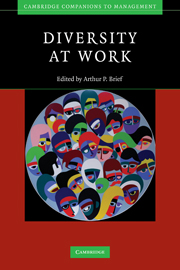Book contents
- Frontmatter
- Contents
- List of figures
- List of tables
- List of contributors
- Foreword
- Preface
- 1 Introduction: Where the sweet spot is: Studying diversity in organizations
- Part I Conceptual foundations
- Part II Emerging theoretical approaches
- 4 Identity negotiation processes amidst diversity
- 5 Diversity, conflict, and their consequences
- 6 Shifting frames in team-diversity research: From difference to relationships
- 7 Putting your own down: How members of disadvantaged groups unwittingly perpetuate or exacerbate their disadvantage
- Part III Moving ahead: Agendas for practice and research
- Index
- References
4 - Identity negotiation processes amidst diversity
Published online by Cambridge University Press: 19 May 2010
- Frontmatter
- Contents
- List of figures
- List of tables
- List of contributors
- Foreword
- Preface
- 1 Introduction: Where the sweet spot is: Studying diversity in organizations
- Part I Conceptual foundations
- Part II Emerging theoretical approaches
- 4 Identity negotiation processes amidst diversity
- 5 Diversity, conflict, and their consequences
- 6 Shifting frames in team-diversity research: From difference to relationships
- 7 Putting your own down: How members of disadvantaged groups unwittingly perpetuate or exacerbate their disadvantage
- Part III Moving ahead: Agendas for practice and research
- Index
- References
Summary
Diversity is the industrialized world's perennial underdog. Though decades of research have yet to reveal any consistent main effects of diversity (Webber and Donahue, 2001; Mannix and Neale, 2005), the increasing diversity of schools, neighborhoods, and workplaces presents an unrelenting demand for effective interaction among diverse people (Friedman and DiTomaso, 1996; Johnson and Packer, 1987; Offerman and Gowing, 1990; Triandis, Kurowski, and Gelfand, 1994). In addition, the successful utilization of diversity undergirds core social values of fairness and justice, along with the organizational prospects of greater learning, innovation, problem solving, and performance (Cox, Lobel, and McLeod, 1991; Ely and Thomas, 2001; Jehn, Northcraft, and Neale, 1999; Robinson and Dechant, 1997; Watson, Kumar, and Michaelson, 1993).
The challenge of realizing the potential value in diversity has motivated two popular streams of research. Organizational researchers working in the tradition of self-categorization theory (and social identity theory) have, on the one hand, generally pursued insight into the universal aspects of encounters with diversity – that is, how people view and interact with others who belong to a different social group, regardless of how the group is defined (e.g., by gender, race, nationality, occupation, tenure, or some combination of demographic dimensions, see Chatman et al., 1998; Polzer, Milton, and Swann, 2002). This approach aims to expose those intergroup dynamics that are likely to emerge as the result of any type of difference, making few or no distinctions between the myriad social identities that may differentiate people.
- Type
- Chapter
- Information
- Diversity at Work , pp. 89 - 126Publisher: Cambridge University PressPrint publication year: 2008
References
- 13
- Cited by

